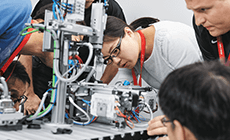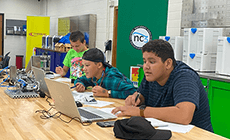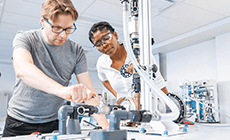
Volume 33, No. 2: Changing Perceptions Changes Lives
Closing the Skills Gap Requires a Wider Talent Pool
Steve Lehr, Director of Business Development – North America, Festo Didactic

With the rise of automation comes the need for highly skilled industrial professionals. Survey information indicates that for most manufacturers attracting and retaining the right talent remains their top challenge. It’s clear that better education and hands-on training is the way forward. In fact, most manufacturers say that upskilling their workers helped improve productivity, promotion opportunities, and morale.
Today’s skills gap, which is the mismatch between the skills possessed by job seekers and the skills needed by employers to fill current and future roles, means that the available talent pool is smaller than general population numbers indicate, which is a major problem. The National Association of Manufacturers forecasts that 2.1 million manufacturing jobs will be unfilled by 2030. Today, most of the workforce development training in the U.S. takes place at two-year colleges. If all those institutions exceeded expectations and graduated 100 manufacturing students per year, the United States would still be short about 1 million skilled workers. Unfortunately, the system is nowhere near this hypothetical graduation rate due to several factors – especially the fact that we simply do not have enough men, women, and young people pursuing manufacturing as a career.

In other words, we must expand the talent pool. Who are we speaking about in this wider pool of future manufacturing workers? The people who have been underrepresented in manufacturing – women, people of color, older workers, English as a second language speakers, those with disabilities, and the recently incarcerated who want to turn their lives around.
We need parents and underserved communities to become aware that manufacturing is a dynamic career choice. The public simply doesn’t know about the high-pay, high-in-demand careers that modern manufacturing offers. As a result, most do not encourage their children or community members to explore manufacturing as a career. How do we convey that education and technology training can be a thrilling hands-on experience that engages the entire person, mind, body, and spirit?

There is also a need to be more flexible in programming. What may work for the traditional applicant to a community college may not be enticing communities of color, first- and second-generation immigrants, or those who think higher education is not for them. Educators and manufacturers may need to start with simple hands-on tasks and more graphics in training to build confidence and work up. Programs must be changed to speak to different interests and learning styles. We can do this, but it will take imagination and a willingness on our part to stretch.

Our job as educators, employers, and public officials is to help people see the opportunities and understand these opportunities are within reach. Those in the wider talent pool must believe that we want them to succeed and are willing to work side by side with them to accomplish that.
It is up to us to awaken broader interest in manufacturing. I know that together we can do great things for our communities and the people who live in them.
 At Festo Didactic, Steven Lehr develops strategies for career and technical education programs in all aspects of industrial automation, fluid power, electrical, robotics, mechatronics, and Industry 4.0. He creates partnerships with government, industry, and education institutions promoting the growth of technical education required to close the skills gap. He is also working on closing the “opportunity gap”, i.e., working with people outside the traditional career track who may not know how to move toward a meaningful job path. A popular speaker, Lehr recently presented before the Texas Industrial Vocational Association, the Pennsylvania Association of Career and Technical Administrators, the Workforce Development Institute, and the High Impact Technology Exchange Conference. He says his Naval Reserves military experience taught him to take care of people, deal with adversity, and never let any situation get the best of him.
At Festo Didactic, Steven Lehr develops strategies for career and technical education programs in all aspects of industrial automation, fluid power, electrical, robotics, mechatronics, and Industry 4.0. He creates partnerships with government, industry, and education institutions promoting the growth of technical education required to close the skills gap. He is also working on closing the “opportunity gap”, i.e., working with people outside the traditional career track who may not know how to move toward a meaningful job path. A popular speaker, Lehr recently presented before the Texas Industrial Vocational Association, the Pennsylvania Association of Career and Technical Administrators, the Workforce Development Institute, and the High Impact Technology Exchange Conference. He says his Naval Reserves military experience taught him to take care of people, deal with adversity, and never let any situation get the best of him.
About Festo Didactic
Festo leverages its automation expertise to provide comprehensive industrial and technical education solutions. Festo Didactic is committed to providing educators and employers with the hands-on training, digital coursework, and blended learning solutions needed to close the STEM skills gap. Our lab equipment, curriculum, and certification programs are thoughtfully designed to support various learning pathways and on-the-job training. With 4,000+ FICP certifications and 36,000 Festo-equipped educational institutions, Festo Didactic and its partners prepare trainees and employees for the future of work. http://www.festo.com.
Connect with Festo Didactic: Facebook, LinkedIn, Twitter and YouTube